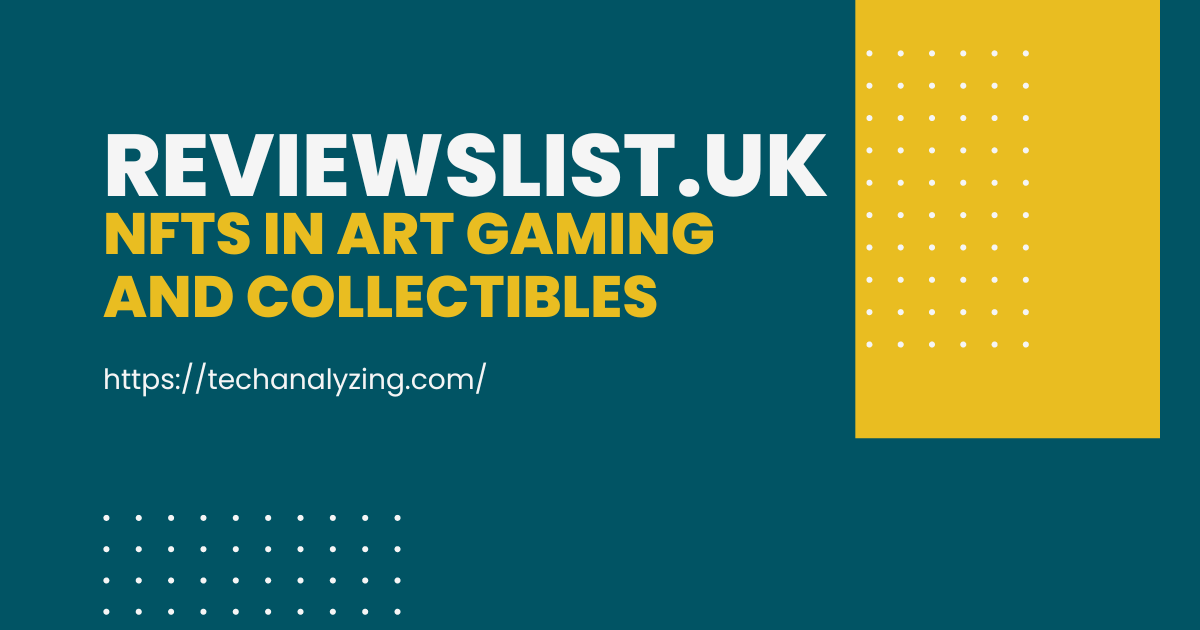NFTs In Art Gaming Reviewslist UK: An In-Depth Review (NFTs)
Introduction:
Non-fungible tokens (NFTs) have become very popular in art, gaming, and collectibles. NFTs are special digital items that use blockchain technology to prove they are original and who owns them. This article will explain NFTs in art gaming reviewslist UK, how NFTs have changed art, gaming, and collectibles, and what might happen with this new technology and its future.
NFTs in art gaming reviewslist UK:
NFTs (Non-Fungible Tokens) are changing how we buy and own digital items. In art, NFTs let artists sell their digital paintings and music directly to buyers. This shows who owns the art and proves it is original. NFTs let players own, trade and sell special game items in gaming. Players can have unique things like swords, outfits, or characters that no one else has. For collectors, NFTs offer a way to own rare digital things like virtual trading cards. Collectors can buy, sell, and trade these items—reviews list. The UK explains how NFTs are used in these areas and makes their impact and potential easy to understand.
Understanding NFTs: Reviewslist.uk/nfts-non-fungible-tokens/
NFTs are digital tokens that show ownership of a unique item or piece of content, like digital art, virtual goods, or collectibles. Unlike cryptocurrencies like Bitcoin, which are identical, NFTs are unique and cannot be traded one-to-one. Each NFT has unique information that makes it unique, ensuring its uniqueness—reviewslist.uk/nfts-non-fungible-tokens/ explains this clearly.
Reviewslist.uk/nfts-in-art-gaming-and-collectibles/

NFTs in Art:
NFTs have significantly changed the art world, giving new opportunities to artists and collectors.
Digital Art Market:
NFTs have created a booming digital art market, letting artists sell their work directly to collectors without needing galleries or intermediaries. This makes it easier for more artists to reach a global audience and profit from their work.
Provenance and Ownership:
NFTs provide a clear and unchangeable record of ownership and history for digital art. This helps buyers verify that a piece is authentic and original, reducing the risk of fake art. Artists can also control their work and earn royalties from future sales.
Accessibility and Inclusivity:
Digital art can be easily shared and viewed online, allowing people worldwide to enjoy and collect art. This inclusivity has opened the art world to new collectors without access to traditional art markets.
NFTs in Gaming:
NFTs are changing the gaming world by allowing the creation and trade of unique in-game items.
Virtual Goods and Assets:
In gaming, NFTs represent virtual items like characters, weapons, skins, and other game assets. Players can buy, sell, and trade these items on different platforms, letting them own and make money from their in-game possessions.
Play-to-Earn Models:
NFTs have introduced play-to-earn models, where players earn NFTs by playing games. These NFTs can be sold or traded, giving players real-world value for their in-game achievements. This model has created new economic opportunities for gamers, especially in developing countries.
Interoperability and Cross-Platform Use:
NFTs allow players to use their in-game assets across different games and platforms. This makes the items more valuable and sound, creating a more connected and immersive gaming experience.
NFTs in Collectibles:
NFTs are changing how we collect, trade, and show off unique items.
Digital Collectibles:
NFTs have made digital collectibles popular. These include trading cards, virtual pets, and digital memorabilia. These items are often limited in number, making them rare and valuable. Collectors can buy, sell, and trade them on different websites, creating a lively market.
Enhanced Ownership Experience:
NFTs improve the experience of owning collectibles by providing proof of ownership and authenticity. This helps collectors trust that their items are authentic and allows them to show their collections confidently.
Community and Engagement:
NFTs have built strong communities among collectors. Websites for NFTs often have social features where collectors can connect, share, and talk about their collections. This sense of community makes collecting NFTs more fun and valuable.
Read more interesting topic: Coyyn What Coins Are Worth Money
The Future of NFTs in Art, Gaming, and Collectibles:

The future of NFTs in art, gaming, and collectibles looks bright, with many new ideas and growth ahead.
Integration with AR and VR:
Combining NFTs with Augmented Reality (AR) and Virtual Reality (VR) will create new, exciting experiences. Artists can make interactive digital art, gamers enjoy more realistic virtual worlds, and collectors can show their collections in virtual galleries.
Mainstream Adoption and Accessibility:
As technology improves and becomes easier to use, more people will use NFTs. Improved accessibility will make it simpler for people to create, buy, sell, and trade NFTs, expanding their reach and impact.
Environmental Considerations:
The environmental impact of NFTs, especially those using energy-intensive blockchains, has raised concerns. Efforts are being made to develop eco-friendly blockchain solutions, like proof-of-stake (PoS) systems, which use less energy. These advancements are essential for the long-term success of NFTs.
Conclusion:
NFTs have changed the art, gaming, and collectibles industries by creating new opportunities for creators, collectors, and gamers. Their unique features, like proving ownership and working across different platforms, have changed how we use digital items. As technology improves and more people use NFTs, their ability to innovate and shape these fields is enormous.
By reading reviews and articles from the reviews list. UK, it’s clear that NFTs are not just a fad but a powerful tool that can reshape the future of art, gaming, and collectibles.
